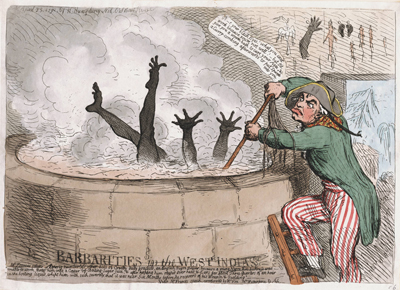Barbarities in the West Indias
In the spring of 1791, few topics were more hotly debated than the motion to abolish the slave trade. Since 1783, a coalition of groups including Quakers, Methodists, and Baptists had been raising awareness of the barbarities committed in the acquisition and employment of slaves to work the British plantations in the West Indies. In 1787 the coalition was joined by several Anglicans including Thomas Clarkson, Granville Sharp, and Philip Sansom forming the Society for the Abolition of the Slave Trade. Clarkson, especially, was active in obtaining evidence from sailors, ship's doctors, former slaves, and others who had first-hand knowledge of the treatment slaves endured. He began presenting this evidence to William Wilberforce who was already an MP and who eventually introduced the measure to Parliament for debate on April 18th and 19th, 1791.
Gillray responded less than a week later with a print based upon evidence and details presented during the debate. The central image shows a British overseer with a flail forcefully submerging a black slave in a vat of boiling sugar juice, apparently for the "crime" of not being well enough to work in the fields. In addition to this punishment, the overseer promises a whipping afterwards "to put Spunk into you." Nailed to the wall behind them are carcasses of a bird and several animals, but, more ominously, the ears and arm of a black slave.

© Lewis Walpole Library, Yale University
The central image is based on remarks made in the course of the debate by a Mr. (Philip?) Francis who, though admitting personal interests in the West Indies, spoke out strongly in favor of abolition.
He dwelt much on the unhappy situation of the Negroes in the West Indies, who were without the protection of Government or of efficient Laws, subject to the mere caprice of men who were, at once, the parties, the judges, and the executioners. He instanced an overseer, who, having thrown a Negro into a copper of boiling cane-juice, for a trifling offence, was punished merely by the loss of his place, and by being obliged to pay the value of the Slave.
The other details most likely derive from the An Abstract of the Evidence delivered before a Select Committee of the House of Commons in the years 1790, and 1791, on the part of the Petitioners for the Abolition of the Slave Trade. In that excruciatingly detailed document, we hear of slaves being flogged on almost any pretext, including
not coming into the field in time, not picking a sufficient quantity of grass, not appearing willing to work, when in fact, sick and not able, for staying too long on an errand, for not coming immediately when called, for not bringing home (the women) the full weekly sum [for prostituting themselves] enjoined by their owners, for running away, and for theft, to which they were often driven by hunger.
The whipping was conducted as follows
The delinquent is stripped and tied on a ladder, his legs on the sides and his arms above his head, and sometimes a rope is tied round his middle. The driver [often another slave] whips him on the bare skin, and if the overseer thinks he does not lay it on hard enough, knocks him down with his own hand, or makes him change places with the delinquent and be severely whipped.... They seldom take them off the ladder, until all the skin, from the hams to the small of the back, appears only raw flesh and blood...
The practice of cutting off ears or hands was not uncommon, according to four different witnesses, one of whom, a Mr. Coor provided the following account:
One of the house girls having broken a plate or spilt a cup of tea, the doctor (with whom Mr. Coor boarded) nailed her ear to a post. Mr. Coor remonstrated with him in vain. In the morning she was gone, having torn the head of the nail through her ear. She was soon brought back, and when Mr. Coor came to breakfast, he found that she had been very severely whipped by the doctor, who, in his fury, clipped both her ears off close to her head, with a pair of large scissars, and she was sent to pick seeds out of cotton, among three or four more, emaciated by his cruelties...
Sources and Reading
- Commentary from the British Museum on Barbarities in the West Indias
- The Abolition Project
- Enslavement and Industrialisation
- The debate on a motion for the abolition of the slave trade in the House of Commons, on April 18th and 19th 1791.
- An Abstract of the Evidence delivered before a Select Committee of the House of Commons in the years 1790, and 1791, on the part of the Petitioners for the Abolition of the Slave Trade.
- Thomas Wright and R.H. Evans, Historical and Descriptive Account of the Caricatures of James Gillray #49
Comments & Corrections
NOTE: Comments and/or corrections are always appreciated. To make that easier, I have included a form below that you can use. I promise never to share any of the info provided without your express permission.